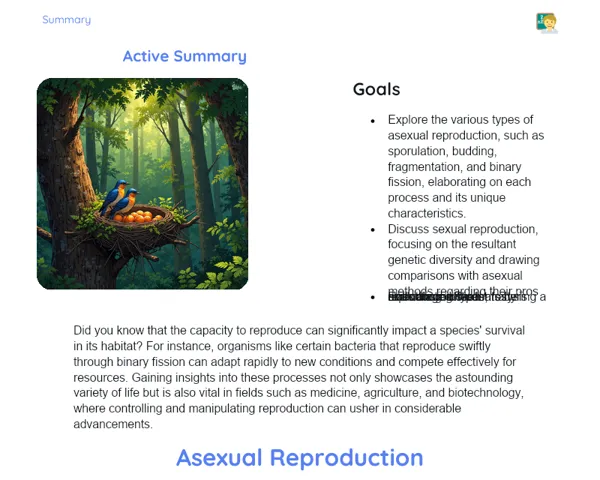Socioemotional Summary Conclusion
Goals
1. 🎯 Understand the unique features of vertebrates and invertebrates.
2. 🔍 Differentiate between the internal skeleton (endoskeleton) and the external skeleton (exoskeleton) across various animal types.
3. 🌟 Develop social-emotional skills like empathy, self-awareness, and self-control by reflecting on our feelings during interactions with different animals.
Contextualization
Have you ever paused to appreciate the astounding variety within the animal kingdom? 🦁🦋 From the regal lion to the diligent little ant, each animal showcases distinct traits that contribute to its role in nature. Learning about the differences between vertebrates and invertebrates enhances our understanding of this intricate web of life and fosters appreciation for every creature we encounter. Moreover, as we reflect on our feelings when interacting with these animals, we cultivate a deeper sense of empathy and respect for the environment. Are you ready to embark on this captivating journey together? 🌍✨
Exercising Your Knowledge
Characteristics of Vertebrates
Vertebrates are one of the most researched groups of animals, encompassing all species with a backbone or spinal column. These animals boast an internal skeleton (endoskeleton) that provides support and safeguards their vital organs, facilitating movement through the coordinated actions of muscles and bones. Examples of vertebrates include mammals, birds, reptiles, amphibians, and fish.
-
🔍 Vertebral Column: All vertebrates have a vertebral column protecting the spinal cord and supporting the body.
-
💪 Endoskeleton: The internal skeleton allows for growth and complex movement.
-
🌱 Development: Several vertebrates undergo intricate stages of development, such as metamorphosis in amphibians.
-
🌍 Diversity: Vertebrates inhabit nearly all ecosystems, showcasing remarkable evolutionary adaptations.
Characteristics of Invertebrates
Invertebrates are animals without a backbone, representing the majority of known animal species. They may have an external skeleton (exoskeleton) for protection and support. Examples include insects, arachnids, crustaceans, and mollusks. They play crucial ecological roles like pollination, decomposition, and forming the base of food chains.
-
🦋 Absence of Vertebral Column: Invertebrates do not possess a backbone and often have an exoskeleton that provides protection and support.
-
🛡️ Exoskeleton: Many invertebrates have a rigid exoskeleton that safeguards them from predators and reduces water loss.
-
🔄 Metamorphosis: Numerous invertebrates undergo impressive transformations, such as the change of a caterpillar into a butterfly.
-
🏞️ Ecosystems: Invertebrates are essential in nearly all ecosystems, fulfilling roles as pollinators, decomposers, and a food source for many species.
Differences Between Endoskeleton and Exoskeleton
Grasping the distinctions between endoskeleton (internal skeleton) and exoskeleton (external skeleton) is vital to understand how various animals support themselves, protect themselves, and move. The endoskeleton allows for continuous growth and complex movements, while the exoskeleton provides sturdy protection but limits growth, necessitating periodic shedding.
-
🦴 Endoskeleton: Present in vertebrates, it enables continuous growth and complex movements – for instance, in humans and fish.
-
🛡️ Exoskeleton: Found in many invertebrates, it offers rigid protection but limits growth, requiring periodic shedding. For example, insects and crabs.
-
📈 Growth: The endoskeleton permits continuous growth, while the exoskeleton needs ecdysis (molting) for growth.
-
📚 Movement: Endoskeletons allow a greater variety of movements due to protected internal joints.
Key Terms
-
Vertebrates: Animals with a backbone and an internal skeleton.
-
Invertebrates: Animals without a backbone, many of which have an exoskeleton.
-
Endoskeleton: The internal skeleton found in vertebrates.
-
Exoskeleton: The external skeleton found in many invertebrates.
-
Metamorphosis: The transformation process experienced by various invertebrates and some vertebrates during their development.
For Reflection
-
✨ How do you feel when you interact with different animals, like a dog or a butterfly, and what do you think causes those feelings?
-
⚖️ How can your understanding of animal diversity shape the way you appreciate and respect the environment?
-
🧠 Recall a recent challenging situation. How could you apply the emotional regulation strategies we discussed in class to handle that better?
Important Conclusions
-
🔍 We learned the key characteristics distinguishing vertebrates from invertebrates, emphasizing the presence or absence of a backbone.
-
💀 We examined the differences between the internal skeleton (endoskeleton) and the external skeleton (exoskeleton), and how they influence animal movement and growth.
-
🌍 We considered the significance of animals in ecosystems and how our emotions might be affected during interactions with various species.
Impacts on Society
Understanding the differences between vertebrates and invertebrates shapes how we perceive and engage with the world around us. Daily, acknowledging these distinctions aids us in identifying and understanding the animals we encounter, whether at home, school, or in nature. This increases our awareness of biodiversity and the intricate ecological connections that sustain our planet.
Additionally, reflecting on our emotions while interacting with animals builds a deeper emotional bond with the environment. This not only enhances our empathy but also inspires us to adopt more sustainable practices and care for our planet. By realizing that our actions can directly impact other forms of life, we nurture a stronger sense of responsibility towards environmental conservation.
Dealing with Emotions
To manage your emotions while studying vertebrates and invertebrates, try using the RULER method at home. First, recognize how you feel about different animals (Recognize). Then, consider why these feelings arise – perhaps you fear spiders or love puppies (Understand). Accurately label these emotions: is it fear, joy, curiosity? (Label). Express your feelings by journaling or discussing them with someone (Express). Finally, work on regulating these emotions: if you feel anxious about an animal, take deep breaths and learn more about it to ease your fears (Regulate).
Study Tips
-
📝 Maintain an emotions journal: As you explore different animals, jot down your feelings and try to understand their causes.
-
🦋 Create a poster: Use visuals and information about vertebrates and invertebrates to craft a poster that aids memorization of their differences.
-
🌐 Watch documentaries: View documentaries focused on animal life to see the discussed concepts in real-life action and deepen your understanding.

